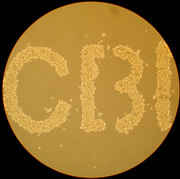In the future, biological/electronic chip implants may be able to restore mental function, the use of limbs, and eyesight. In the near future, in vitro neural networks consisting of millions of living, interconnected nerve cells, will be used to test drugs and sense neurotoxins. Before any of this can happen, however, scientists must learn how neurons in the human system communicate with each other.
Making a quantum leap towards this goal, a multidisciplinary team of scientists and engineers from Berkeley Lab, led by Eleanor A. Blakely and Ian G. Brown, has developed a technique for growing large arrays of networked neurons, in virtually any pattern desired, on the prepared optical surface of a charge-coupled device (CCD). The result is a biological-electrical interface device called the Neural Matrix CCD. The ability to precisely control the growth pattern of the neurons on the CCD is of great importance in isolating and identifying behaviors such as neuronal networking, the process by which neurons preferentially connect to some neurons and not others.

The Berkeley Lab scientists have been collaborating with Cellular Bioengineering Incorporated (CBI), a small business located in Honolulu, Hawaii, to further develop the Neural Matrix CCD. This research, which focuses on neurotoxin detection, is being funded by the Center of Excellence for Research in Ocean Sciences (CEROS), a program of the Defense Advanced Research Projects Agency (DARPA).
While neural networks consisting of less than a hundred neurons have been studied before, the methods used to do so can’t be scaled up to detect adequately the precise location and history of nerve activity in large neuronal arrays. In contrast, the new Berkeley Lab technology is able to pattern the growth of up to a million neurons and to stimulate and monitor the activity of the individual neurons in these networks by taking advantage of the ability of a CCD to act as an electrostatic pickup device – recording the signals from individual nerve cells, in real time, and mapping them within the neural network.
While most other neuron patterning and monitoring techniques are invasive, in the Neural Matrix CCD method the nerve cells remain undisturbed during monitoring. This means that second messenger molecules and critical intracellular substances such as ATP remain unaffected. It also means observations can be carried out over several months.
As we learn more about the growth of neural networks, the Neural Matrix CCD may become the basis for devices that can interface with patients’ biological systems, helping those affected by multiple sclerosis, Alzheimer’s, or Parkinson’s. These implants might also be able to restore mental function lost due to brain injury or disease and repair spinal cord or nerve damage. By knowing what drugs or stimulation protocols most effectively stimulate synaptic connections, the technology could be used to promote nerve regeneration.
